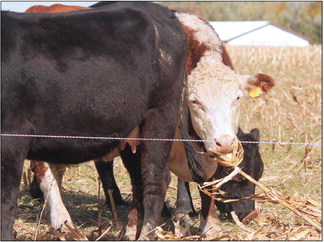A cover crop success story


Lechleitner farm shows benefits of no-till cropping
If you grow less corn, can you wind up with more feed?
The answer is yes if you plant a cocktail mix of cover crops in between the rows. That was the bottom line message at an Eau Pleine Partnership for Integrated Conservation field day discussion held at the Lechleitner family farm, town of Rietbrock, last week Wednesday.
The family displayed their experiment in interseeding a mix of cover crop plants in corn planted in 60-inch rows. The cover crops included ASRF, trophy rape, dwarf Essex rape, crimson clover, red clover, oats, cow peas and sunflowers. The cover crop was planted across 27 acres of corn on June 15.
This fall, after the corn is harvested, the family is letting their 65 beef cows graze the cover crops.
Kelby Lechleitner, who helps with crops on the farm, said he likes what he sees in the experiment.
He said the widely spaced corn produces better than corn raised in conventional 30-inch rows.
“There is more growing opportunity for the corn,” he said. “More water and sunlight.”
Lechleitner said letting the beefers graze the cover crops and corn stubble is a major time-saver and he appreciates the soil benefits that come with no-till cover cropping.
“This just makes sense for us,” he said.
The Lechleitners’ no-till field corn looks excellent, no different than conventional corn grown during this stellar growing year. A ribbon of green, flowering cover crops runs through the rows of tan, dry corn stalks with large cobs hanging low.
Gary Lechleitner, Kelby’s father, said he’s typically “old school” when it comes to crop production, but said he appreciates how the cover crops interseeded between the corn seem to be building soil health. His soil is less prone to compaction by repeated passes with a tractor, he said.
“I don’t like compaction,” the senior Lechleitner said. “This is amazing.”
During the field day, there was a robust discussion concerning whether the experiment was more profitable than conventional cropping.
Participants said the Lechleitners probably weren’t fattening cattle the most efficient way possible, but, by grazing cattle on the cover crops, the family was benefitting from building soil health with the cover crops. The soil is further helped with cattle leaving manure on the land.
Others at the field day said the Lechleitners were giving their cattle a good balanced diet of corn stalks and stubble along with the smorgasbord of cover crops. Some participants recommended rye be emphasized in the cover crop mixture.
The Lechleitner family used to operate a dairy, but, after selling their cows, raise both beef and ginseng.
